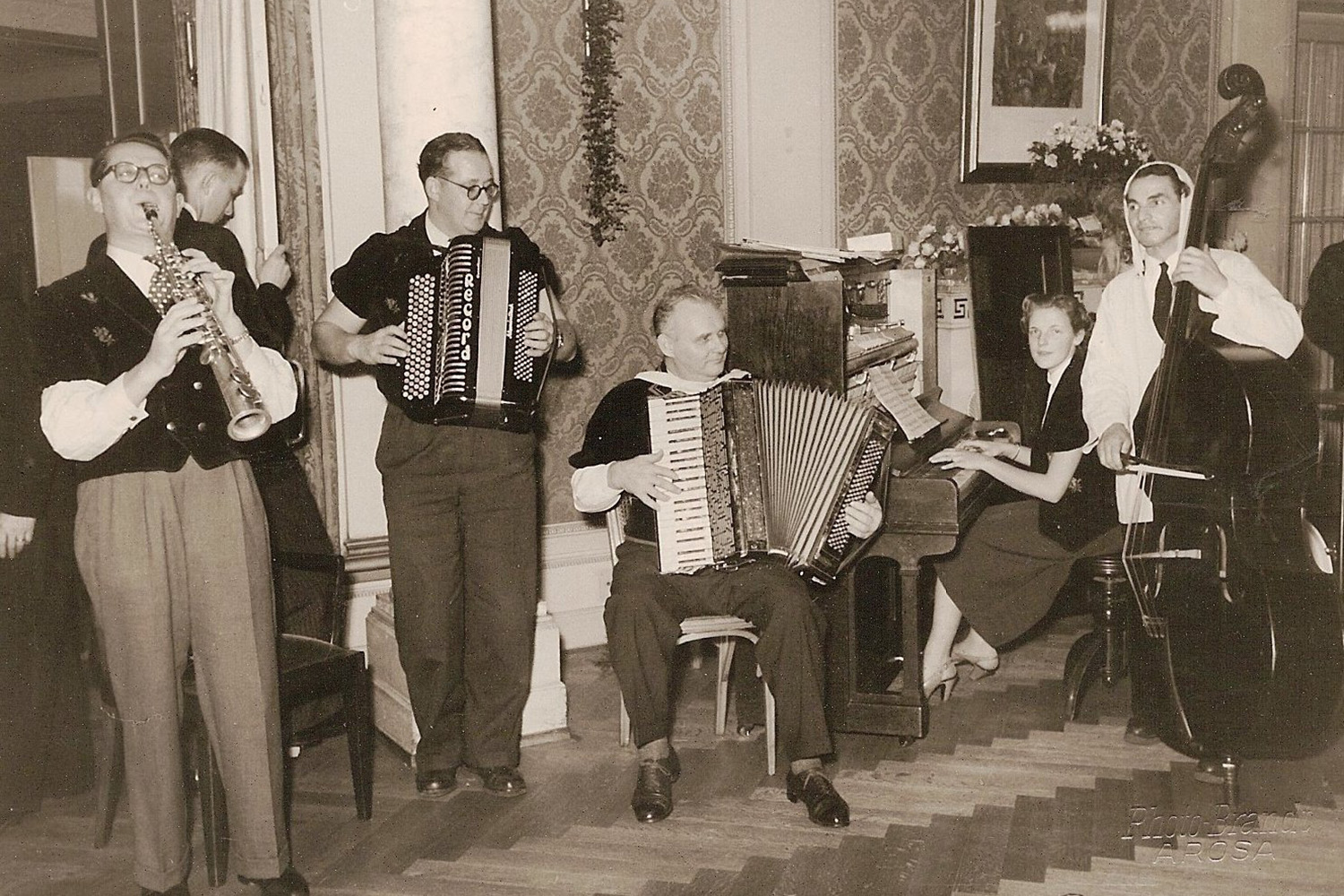At the opening of the book “Die neue Volksmusik” [The new folk music], the ethnomusicologist Dieter Ringli writes, in no uncertain terms: “The idea that folk music is a centuries-old unchanged tradition is simply historically false.” Swiss folk music has always been changing – and at the beginning of the 20th century particularly so. Only then did the hand organ begin to establish itself in semi-professional dance music bands. Reason for this: Instruments such as the accordion or the Schwyzerörgeli were louder and could be played chordally. This made it possible to substitute other instruments such as the violin and trumpet, allowing for smaller, easier to coordinate, and less expensive instrumentation. Which, in turn, allowed to play faster, which was also practised in the old repertoire from the 19th century.
Inspiration and audience in Zurich
Thus, in the first decades of the 20th century, a new style emerged, which stood out with an astonishingly innovative attitude of its exponents until the 1950s and is still called Ländlermusik today. Madlaina Janett and Dorothe Zimmermann state in their book “Ländlerstadt Züri” [Ländler city Zurich] that “so-called Ländler kings like Stocker Sepp, Kasi Geisser or Jost Ribary shaped the sound in Zurich, which later went down in history as Swiss national music”. Dieter Ringli writes that in its heyday in the 1930s and 1940s, Ländler music had achieved national fame and was the undisputed number one music for dance and entertainment.
This also had to do with the fact that the Ländler contributed a great deal to the definition of Swiss identity in the sense of intellectual national defence. This was expressed in particular at the national exhibition of 1939 in Zurich. During World War II, moreover, there was little foreign competition. The success of the Ländler was also strengthened by the emerging media, radio and records, in the 1920s.
Change of instrumentation
Early on, hand organ(s), clarinet(s) and double bass were established as the basic instrumentation of Ländler music, but experiments were made with other instruments, such as trombone or piano. The example of Heiri Meier shows how strongly individual musicians from central Switzerland shaped the development of this actually urban form of folk music.
The clarinettist, who was originally from Lucerne, had discovered newer styles such as Schlager and jazz or swing in Zurich in the 1920s – and was inspired by them, certainly in the sense of adapting to the current taste of the public. Heiri Meier, for example, created the Ländler-Fox, a rhythmic reference to the fashionable dance, the Foxtrot. He also introduced the soprano saxophone, which still creates a stir in Ländler circle discussions today. Heiri Meier is also one of the outstanding figures of the Ländler, because he composed numerous new pieces such as “Klänge vom Pilatus” [Sounds from the Pilatus], which, according to experts, are characterized by “originality and indestructibility”.
A rural and exotic charm
Heiri Meier soon performed abroad, often as a member of Stocker Sepp’s band. Like most of the musicians who set the style in Zurich, he came from central Switzerland, more precisely from Wollerau, canton Schwyz. Like most people who chose the rural exodus, the clarinettist sought a better income in the city, where he encountered great interest in rural culture. That is why Stocker Sepp soon gave up his traditional profession as a printer and typesetter and became a professional musician. However, he and his fellow musicians did not perform in Sunday suits, as was customary in the past, but in shepherd’s shirts. According to Dieter Ringli, many other country musicians also wore traditional costumes in order to “reinforce the rural-exotic appeal to the urban audience.” Stocker Sepp is even said to have adapted the name of his formation to the city dwellers’ need for the rural and farming touch: He called them “1. Unterwaldner Bauernkapelle” [First Unterwalden farmers’ band], although its members were neither from Unterwalden nor farmers.
Success abroad as well
It is therefore not surprising that the journalist Kurt Zurfluh also describes Stocker Sepp as a busy organizer and marketer. Around 1930 he is said to have been engaged several times with his band for week-long performances in Paris and London, where he also had his music recorded. He did this since 1922, having recognized early on the importance of the emerging recording industry; by 1938, he is said to have recorded and successfully sold over 400 musical pieces on record. In a survey of the best-known musicians in Zurich and the surrounding area, Stocker Sepp is said to have received 93,568 votes according to the evaluation of the 118,000 (!) questionnaires received, followed by Walter Wild and the Zug clarinettist Jost Ribary Sr. The highlight of his career was a series of performances at the 1939 National Exhibition in Zurich.
Unique personality
Clarinettist Kasi Geisser was born in Arth, canton Schwyz, and apprenticed as a glassblower in the nearby Goldau light bulb factory. That is where he met Dominik Märchy, with whom he gained a good reputation as a musician. He thus soon focused fully on music, moved to Zurich at the age of 20 and, according to Volksmusik.ch, developed into “probably the most influential Ländler musician of modern times”. His “colourful personality” and his “unsteady life” are said to have contributed significantly to the creation of the legend. But he also had a formative influence on style as a performer and composer, not least writing countless pieces such as “Abend am Vierwaldstättersee” [Evening at the Vierwaldstättersee]. As early as 1926, he recorded his own dances on records in Berlin, and shortly thereafter he made a series of no less than 20 records for the Polydor label in Lausanne.

New standards
Jost Ribary Sr., clarinettist and saxophonist, set new standards in playing technique and composition from 1930 onwards, not least because he took lessons from a clarinettist of the Tonhalle Orchestra. Accordingly, it is astonishing that his innumerable pieces or “Tänzli” [dances] were perceived as folkloric despite their sophistication. With Ländler classics such as, in particular, “Steiner Chilbi” [Steinen fair] and the hit song “Komm in meinen Rosengarten” [Come into my rose garden], which was written by Martha Wild, he became one of the first recording stars, even performing in England and Holland. His radio recordings also contributed a lot to the fact that even Ländler fans from abroad, including American-Swiss, made a pilgrimage to Zurich, where he often performed in the Niederdorfneighbourhood , mostly in the Ländler inn “Konkordia”, above which he also opened a repair shop for the harmonica and where he lived from time to time. One of his compositions is thus called “Stimmung im Niederdorf” [Mood in Niederdorf].
Book tips
Dieter Ringli: “Schweizer Volksmusik von den Anfängen um 1800 bis zur Gegenwart” [Swiss Folk Music from the Beginnings around 1800 to the Present] (Mülirad Publishing).
Dieter Ringli, Johannes Rühl: “Die Neue Volksmusik. Siebzehn Porträts und eine Spurensuche in der Schweiz”. [The New Folk Music. Seventeen Portraits and searching for clues in Switzerland] (Chronos Publishing).
Madlaina Janett, Dorothe Zimmermann: “Ländlerstadt Züri. Alpen, Tracht und Volksmusik in der Limmatstadt” [Ländler city Zurich. Alps, Traditional Costume and Folk Music in the City on the Limmat] (Elster Publishing).
SUISA celebrates its centenary in 2023. In 1923, the first Swiss collective management organisation, MECHANLIZENZ, was founded in Bern. One year later, GEFA emerged, which has been called SUISA since 1942. In 1982, the two companies merged.
Much has changed since 1923, both in the music business and in society. On the occasion of the centenary, a coffee-table book is created. It provides a retrospective of the last 100 years of the Swiss music scene and SUISA’s development. On SUISAblog, selected topics from the book will be examined in more detail.




